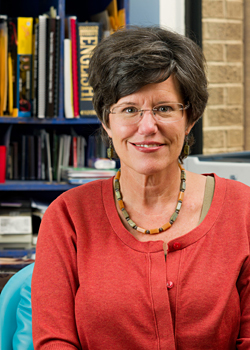Carolyn Tate
2011 Texas Tech Integrated Scholar
Professor of Art History, School of Art;
College of Visual & Performing Arts
 The good thing about teaching in a university and a research institution is that it
is a blend of activities. You don't just teach. You keep your teaching alive by doing
research. And you keep the institution alive by doing service.
The good thing about teaching in a university and a research institution is that it
is a blend of activities. You don't just teach. You keep your teaching alive by doing
research. And you keep the institution alive by doing service.- Carolyn Tate
What is your research objective/interest(s)?
People have profound reactions to their physical environments. We build economies and societies based on the physical qualities of places. In many societies, people ascribe spiritual qualities to the formations of land, the flow of water, and the miracle of growth. My research into Mesoamerica has explored the history of several important ceremonial centers and has tried to remain open to discerning the philosophical as well as the material motivations of the people who built them. The focus on place has led to a variety of discoveries, from the efforts of ancient Maya kings to enhance the meaning of their monuments through astronomical alignments, to the overwhelming emphasis on the process of human gestation as a symbol for the mystery of life among the Olmec, North America's earliest civilization.
How do you feel your research impacts the globe?
Discovering the complexity and sophistication of native American civilizations engenders respect. Many students whose ancestors came from Latin America find a greater sense of self-respect and an understanding of their family's traditions and languages. Other students learn how different civilizations can be from ours in the U.S. today. They begin to see the internal logic of societies for whom life is a precious and precarious gift, and that knowledge helps them realize that each person and society is worthy of respect. By studying the ancient civilizations of the Americas we connect ourselves with this continent and its Pre-Columbian peoples. Each person builds his or her own response to living in this long-inhabited land. History provides us with detailed knowledge of the successes and failures of the past so that we can be aware of a wider range of solutions to the problems that face us today.
Where do you get your inspiration?
Inspire: to breathe into.
I am nourished by the hearts of my family, the efforts of my students, and the diligence of my colleagues.
What type(s) of service projects do you enjoy doing?
Service is the best way to learn and to care, so I embrace a variety of projects. I actually like working on administrative procedures because they help all concerned establish common understandings. In addition to university service I stay active in several community groups as well, which provide fun, humanity, humility, and balance to life.
What are you currently working on?
The book I am finishing has taken twelve summers, but it does cover a millennium. Despite the fact that early scholars recognized many images of women and babies in Olmec visual culture, Olmec society has always been characterized as early agriculturalists whose religious life involved either a jaguar cult or male shamanic rulers. By studying sculptures and ancient sites, I'm tracking images of women, unborn humans, and babies across Mesoamerica, and offering a much more balanced explanation of the development of Olmec visual culture.
What advice do you have for new faculty members on balancing the components of an integrated scholar into their careers (academics, research, and service)?
Focus on your strengths.
Scholar Background
I come from a military family and have lived in thirty-nine cities and five countries. Several years in Okinawa during the Vietnam conflict opened my eyes to both non-western societies and what it is to be an American. Once I did not have to move with my family each year, I adopted Austin as an educational home. The University of Texas provided so many fascinating courses! Professors were living their research, too. Although my degrees were in art history, the other courses I took benefitted me in ways I could not have predicted. For example, gem minerals informed my career as a curator of ancient sculpture, and Mahayana and Vedanta philosophy classes provided alternative vantage points to Christianity as I have studied ancient American thought.
Office of the Provost
-
Address
104 Administration Building, Box 42019, Lubbock, Texas 79409-2019 -
Phone
806.742.2184 -
Email
provost.communications@ttu.edu
